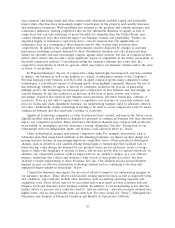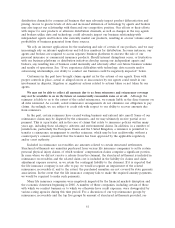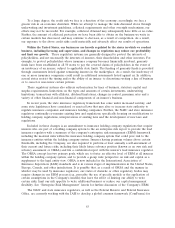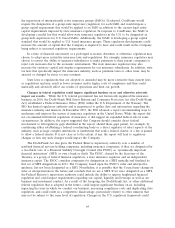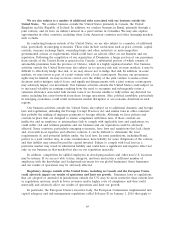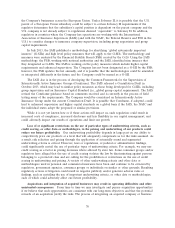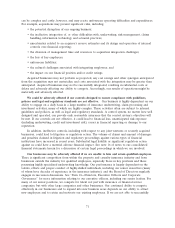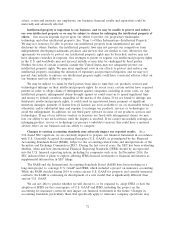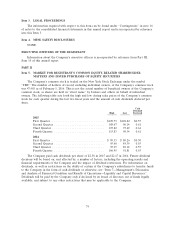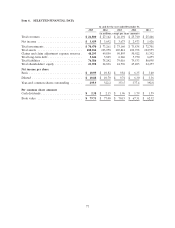Travelers 2015 Annual Report Download - page 67
Download and view the complete annual report
Please find page 67 of the 2015 Travelers annual report below. You can navigate through the pages in the report by either clicking on the pages listed below, or by using the keyword search tool below to find specific information within the annual report.frequency and severity of losses, among others, that are difficult to make and may differ materially
from actual results.
Whether we use a proprietary or third party model, future experience may be materially different
from past and current experience incorporated in a model’s forecasts or simulations. This includes the
likelihood of events occurring or continuing or the correlation among events. Third party models may
provide substantially different indications than what our proprietary modeling processes provide. As a
result, third party model estimates of losses can be, and often have been, materially different for similar
events in comparison to our proprietary estimates. The differences between third party model estimates
and our proprietary estimates are driven by the use of different data sets as well as different
assumptions and forecasts regarding the frequency and severity of events and claims arising from the
events.
If we fail to appropriately price the risks we insure, or fail to change our pricing model to
appropriately reflect our current experience, or if our claims experience is more frequent or severe than
our underlying risk assumptions, our profit margins may be negatively affected. If we underestimate the
frequency and/or severity of extreme adverse events occurring, our financial condition may be adversely
affected. If we overestimate the risks we are exposed to, we may overprice our products, and new
business growth and retention of our existing business may be adversely affected. As we expand into
different markets and geographies, we will write more policies in markets and geographical areas where
we have less data specific to these new markets and geographies, and, accordingly, we may be more
susceptible to error in our models and strategy. See ‘‘Item 7—Management’s Discussion and Analysis
of Financial Condition and Results of Operations—Catastrophe Modeling.’’
Our business success and profitability depend, in part, on effective information technology systems
and on continuing to develop and implement improvements in technology. We depend in large part
on our technology systems for conducting business and processing claims, as well as for providing the
data and analytics we utilize to manage our business, and thus our business success is dependent on
maintaining the effectiveness of existing technology systems and on continuing to develop and enhance
technology systems that support our business processes and strategic initiatives in a cost and resource
efficient manner. Some system development projects are long-term in nature, may negatively impact
our expense ratios as we invest in the projects and may cost more than we expect to complete. In
addition, system development projects may not deliver the benefits or perform as expected, or may be
replaced or become obsolete more quickly than expected, which could result in operational difficulties,
additional costs or accelerated recognition of expenses. If we do not effectively and efficiently manage
and upgrade our technology portfolio, including with respect to the technology portfolio of our recently
acquired businesses, or if the costs of doing so are higher than we expect, our ability to provide
competitive services to new and existing customers in a cost effective manner and our ability to
implement our strategic initiatives could be adversely impacted.
If we experience difficulties with technology, data and network security, outsourcing relationships,
or cloud-based technology, our ability to conduct our business could be negatively impacted. While
technology can streamline many business processes and ultimately reduce the cost of operations,
technology initiatives present significant risks. Our business is highly dependent upon our employees’
ability to perform, in an efficient and uninterrupted fashion, necessary business functions. A shut-down
of, or inability to access, one or more of our facilities (including our primary data processing facility); a
power outage; or a failure of one or more of our information technology, telecommunications or other
systems could significantly impair our ability to perform such functions on a timely basis, particularly if
such an interruption lasts for an extended period of time. In the event of a computer virus or disaster
such as a natural catastrophe, terrorist attack or industrial accident, our systems could be inaccessible
for an extended period of time. In addition, because our information technology and
telecommunications systems increasingly interface with and depend on third-party systems, including
cloud-based, we could experience service denials or failures of controls if demand for our service
67




